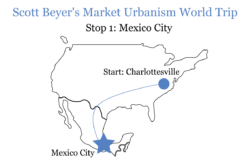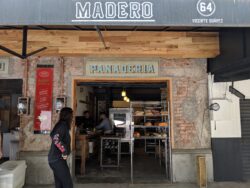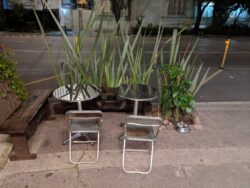What Mexico City Can Teach the U.S. About Parklets
In a city of low car ownership and small retail storefronts, parklets expand seating capacity.
Note: this is the last Latin America article in Beyer’s “Market Urbanism Around the World” series. Next week his coverage moves to Africa.
Mainstream America only recently got acquainted with parklets. When outdoor dining was legalized as an emergency during COVID-19, U.S. cities adapted by reserving parking space for these structures. But in Mexico City, they’re much more of an established part of the urban fabric, and make a statement on the economics of good urban spatial use.
The “parklet” term refers to a small structure along a sidewalk curbside that extends into the street. Occasionally parklets are covered, and sometimes, but not always, used for outdoor dining. Elsewhere, such as in San Francisco, they aim to improve the pedestrian experience with seating. But they are nonetheless rare in America.
In June of 2022, Ethan Finlan and I co-authored a Catalyst piece on why parklets should stay even after the return of indoor dining. Our logic was that cities underutilize curb space by designating it for free or under-priced parking. Granting it instead to restaurants for greater seating capacity would increase economic activity. Better yet, having a market-based pricing system, where either restaurants or drivers bid for the curb space, would lead to its highest and best use.
Mexico City doesn’t have this market-based system, but still applies some of these principles. In certain neighborhoods, such as Condesa and Roma, parklets abound.

One business I saw, a bakery in Condesa, had no indoor seating. But it had a parklet with outdoor seating for up to 20 customers, consuming space that would be needed for only one parked car.
Think about the economic boost this presents for the business: the bakery loses out on one parking space (often a contentious issue for U.S. merchants). But it enjoys far more customer traffic. In the hour I sat down, there were probably 30 other patrons, so it’s safe to assume the restaurant did hundreds of dollars in sales beyond what it would do without seating.
This matters, because Mexico City is full of small entrepreneurs—in fact it’s the prevailing economic order for all of LatAm. While data for Condesa isn’t available, the cost of retail space per square meter in Mexico City’s historic core is around $1,124. For this reason many retail storefronts are small, containing few or no indoor seats. Much like accessory commercial units, parklets can enable smaller-scale entrepreneurship by reducing the startup costs associated with real estate.

Many of the parklets have visual appeal, with plants and flowers. In other parts of the city where parklets don’t exist, a parklet-like setup has nonetheless been allowed on sidewalks.

As with many of the wondrous Latin American planning concepts, it’s unclear which policy program led to all these parklets in Mexico City. They’re just there.
But a look at other local policies and attitudes shows what might have inspired the parklets. In 2017, city leadership decided to nix minimum parking requirements leading to much fewer parking stalls getting built. For retail it went a step further, capping how many spaces a business could install. More generally, Mexico City has designated other aspects of its streets for more diverse uses than parking. For instance, many streets in those Roma and Condesa neighborhoods have wide medians, bus-only lanes, tree plantings, and park-like bulbouts.
So there’s a philosophical principle at play: local officials see that by designating much of the public right-of-way for pedestrian enjoyment and other uses, it enhances the overall atmosphere. The strategy has worked for Roma and Condesa, both among Mexico City’s most expensive neighborhoods.
Some U.S. cities are embracing parklets. Atlanta established a program to sell parklet infrastructure to interested businesses. San Francisco established a legal framework for their installation in summer 2021 (although in typical fashion, it’s proven famously bureaucratic). And various other cities keep parklets intact as outdoor dining remains popular. But as with other measures that diversify what road space is used for, there is severe opposition to losing parking spaces. And beyond the parking tradeoff, there are sometimes micromanaging design rules—in San Diego, for instance, regulations forbid a “permanent roof structure.”
The Mexico City example speaks to how even a place with high traffic can create little oases in the city that feel gardenesque, and parklets play a big role in achieving that. But their main role is assisting small businesses by granting them extra real estate in a space-constrained setting. U.S. cities wishing to bolster entrepreneurship and vibrancy should consider using some of their own on-street parking space for parklets.
All images credited to Scott Beyer and The Market Urbanist.
Catalyst articles by Scott Beyer | Full Biography and Publications
